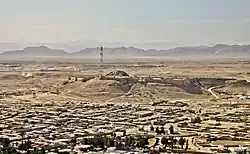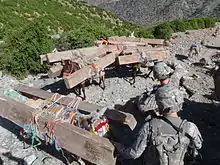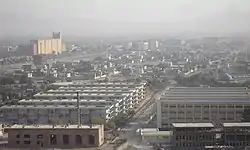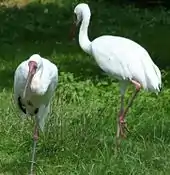Environmental issues in Afghanistan
Environmental issues in Afghanistan are monitored by the National Environmental Protection Agency (NEPA).[1] They predate the political turmoil of the past few decades. Forests have been depleted by centuries of grazing and farming, practices which have only increased with modern population growth.

In Afghanistan, environmental conservation and economic concerns are not at odds; with over 44% of the population dependent on herding or farming,[2] the welfare of the environment is critical to the economic welfare of the people. In 2007, the World Health Organization released a report ranking Afghanistan as the lowest among non-African nations in deaths from environmental hazards.[3]
Climate change

Climate change in Afghanistan has led to a temperature increase of 1.8°C since 1950 in the country. This has caused far-reaching impacts on Afghanistan, culminating from overlapping interactions of natural disasters (due to changes in the climate system), conflict, agricultural dependency, and severe socio-economic hardship.
Combined with infrequent earthquakes, climate-related disasters such as floods, flash floods, avalanches and heavy snowfalls on average affect over 200,000 people every year,[4] causing massive losses of lives, livelihoods and properties.[5][6][7][8] These interacting factors, particularly protracted conflicts which erode and challenge the ability to handle, adapt to and plan for climate change at individual and national levels, often turn climate change risks and hazards into disasters.
Although the country itself contributes only very little to global warming with regards to greenhouse gas emissions, droughts due to climate change affect and will affect Afghanistan to a high degree.
Due to a combination of political, geographic, and social factors, Afghanistan is one of the most vulnerable nations to climate change impacts in the world,[9][10] ranked 179 out of 185 countries.[11][12][13] As of 2021, the Asian Development Bank (ADB) has committed more than $900 million,[14] for irrigation and agriculture infrastructure projects to help with food security, agribusiness, and enhancement of water resources management through a climate resilience approach.[15]Deforestation


Felling has been made illegal all over Afghanistan.[16][17][18] According to NEPA, only about 1.5% of the country is forested.[19] Others have put the figure at 2.1% (or 1,350,000 ha).[20] Some steps have been taken in recent years to plant trees in the urban areas of the country.[21][22][23][24][25] Afghanistan had a Forest Landscape Integrity Index mean score of 8.85/10, ranking it 15th globally out of 172 countries.[26]
Afghans have historically depended on forests for firewood and the revenue generated by export of pistachios and almonds, which grow in natural woodlands in the central and northern regions. The Badghis and Takhar provinces have lost more than 50% of pistachio woodland. In the past many have used wood for fuel, and those such as the Northern Alliance have cleared trees which could have provided hiding places for ambushes from the Taliban. Further, the use of the woodlands for grazing ground and the collection of nuts for export apparently prevent new pistachio trees from growing.[27]

Afghanistan has lost nearly half of its forests.[28][29][30] Denser forests in the eastern Nangarhar, Kunar, Nuristan and other provinces are at risk from timber harvesting by timber mafia. Although the logging is illegal, profits from exporting the timber to neighboring Pakistan are very high.[31][32] The reason for this is that Pakistani government has its forests tightly protected so the timber mafia are busy cutting down trees in Afghanistan instead. The timber makes its way not only to Peshawar but also to Islamabad, Rawalpindi, and Lahore, where most of it is used to make expensive furniture. The Afghan government has formed special park rangers to monitor and stop these activities.[17][33]
As forest cover decrease, the land becomes less and less productive, threatening the livelihood of the rural population and the floods are washing the agricultural lands and destroying the houses. Loss of vegetation also creates a higher risk of floods, which not only endanger the people, but cause soil erosion and decrease the amount of land available for agriculture. To reverse this destruction, MAIL is attempting to turn Afghanistan green again by planting millions of trees every spring, particularly on the 10th of March, which is recognized as national tree plantation day in the country.[34][35][36][37][38][39][40]
Wildlife
Hunting is illegal in Afghanistan because much of the country's wildlife is at risk of being extinct.[41] Exotic birds and wild animals continue to be smuggled out of the country.[42] In 2014 around 5,000 birds were smuggled out of Afghanistan, which included falcons, hawks and geese.[43] In 2006, Afghanistan and the Wildlife Conservation Society began a three-year project to protect wildlife and habitats in Band-e Amir National Park and Wakhan National Park.[44]
Endangered species
- Asian black bear (Ursus thibetanus)
- Falcon[45][46]
- Houbara bustard (Chlamydotis undulata)[47]
- Marco Polo sheep (Ovis ammon polii)
- Markhor (Capra falconeri)
- Siberian crane (Grus leucogeranus)
- Snow leopard (Uncia uncia)[48]
- Urial (Ovis orientalis)
- Wild goat (Capra aegagrus)[42]
Critically endangered species
- Corn crake (Crex crex)
- Eastern imperial eagle (Aquilla heliaca)
- Greater spotted eagle (Aquilla clanga)
- Lesser kestrel (Falco naumanni)
- Marbled duck (Marmaronetta angustirostris)
- Pallas's fish eagle (Haliaeetus leucoryphus)
- Sociable lapwing (Vanellus gregaria)
- White-headed duck (Oxyura leucocephala)
- Yellow-eyed pigeon (Columba hodgsonii)
Little is known about the status of the salamander Batrachuperus mustersi, which is found only in the Hindu Kush.
Water management

Most of Afghanistan's fresh water flow by fast-flowing rivers into neighboring countries.[49][50] This naturally benefits those countries but not Afghanistan.[51][52][53][54][55] The primary threat to Afghanistan's water supply is the droughts, which have created food shortages for millions of Afghans in the past.[56][57] The resulting agricultural crises between 1995 and 2001 have driven many thousands of families from rural to urban areas.[58] In response to drought, deep wells for irrigation have been drilled which decreased the under ground water level, further draining groundwater resources, which rely on rain for replenishment.[36] More dams and reservoirs are also being built to counter droughts.[59][60][61][62]
According to UNICEF, only around 67% of the population of Afghanistan has access to clean drinking water.[63] This number is expected to steadily increase in the future,[64] especially after the Qosh Tepa Canal and the Shahtoot Dam are completed. Major international organizations helping Afghanistan better manage its water resources have been Indian and German.[50][65][66]
Between 1998 and 2003, about 99% of the Sistan wetlands were dry, another result of continued drought and lack of water management.[67] The wetlands, an important habitat for breeding and migrant waterfowl including the dalmatian pelican and the marbled teal, have provided water for agricultural irrigation for at least 5,000 years. They are fed by the Helmand and Farah rivers, which ran at 98% below average in drought years between 2001 and 2003. As in other areas of the country, the loss of natural vegetation resulted in soil erosion; here, sandstorms submerged as many as 100 villages by 2003.[27]

Some of the major water reservoirs and dams include the following:
- Ab-i Istada in Nawa District of Ghazni Province
- Band-e Amir in Yakawlang District of Bamyan Province
- Dahla Dam in Shah Wali Kot District of Kandahar Province
- Darunta Dam in Nangarhar Province
- Hamun Lake in Chahar Burjak District of Nimruz Province
- Kajaki Dam in Kajaki District of Helmand Province
- Kamal Khan Dam in Chahar Burjak District of Nimruz Province
- Naghlu Dam in Surobi District of Kabul Province
- Qargha Reservoir in Kabul Province
- Salma Dam (Afghan-India Friendship Dam) in Chishti Sharif District of Herat Province
- Sarda Dam in Andar District of Ghazni Province and Sharana District of Paktika Province
- Shah wa Arus Dam in Shakardara District of Kabul Province
- Sultan Dam in Jaghatu District of Ghazni Province
- Zorkul in Wakhan District of Badakhshan Province
Pollution

Since 2002, over 5 million Afghan citizens that were living in Pakistan and Iran have returned to Afghanistan. Many of them settled in the big cities, particularly in Kabul, Kandahar, Herat, Mazar-i-Sharif and Jalalabad.
Air pollution
Air pollution in Afghanistan's major cities is becoming a serious problem to public health.[19][68] Residents of Kabul suffer the most from air pollution.[69][70] Over 2,000 Kabul residents die from air pollution each year.[71] Large number of vehicles in the city is the main reason for this.[72]
Nationally, an estimated 5,000 people die from air pollution.[73][74][75] Some sources have given a much higher number of deaths in the past.[76] Vehicles are also blamed for the air pollution in the other cities.[77]
Domestic and industrial waste
Afghanistan has long lacked a proper sewage system.[78][79] In 2002, the United Nations Environment Programme found that a lack of waste management systems was creating dangerous conditions in several urban areas.[27] In Kabul's districts 5 and 6, household and medical waste was discarded on streets. Human waste was contained in open sewers, which flowed into the Kabul River and contaminated the city's drinking water.
Urban dumpsites have been used in lieu of managed landfills in Kabul, Kandahar and Herat, often without protection of nearby rivers and groundwater supplies. Medical waste from hospitals is sometimes disposed in the dumpsites with the rest of the cities' waste, contaminating water and air with bacteria and viruses.
Lack of sewage management is not unique to Kabul. In urban areas, open sewers are common while wastewater treatment is not. Much of the urban water supply is contaminated by Escherichia coli and other bacteria.
Oil refineries are another source of water contamination. In Herat and Mazar-i-Sharif, crude oil spills and leaks are uncontained and unsafe levels of hydrocarbons reach residential water supplies.
Nuclear waste by Pakistan
In 2008, the Afghan government stated that it was investigating allegation that Pakistan had dumped nuclear waste in southern Afghanistan during the Taliban rule in the late 1990s.[80]
References
- "NEPA Says Air Pollution in Kabul Increased Significantly Over Past Week". TOLOnews. 10 June 2023. Retrieved 2023-08-11.
- "Afghanistan: Labor force - by occupation". World Factbook. CIA. 2017. Retrieved 2021-02-26.
- "New country-by-country data show in detail the impact of environmental factors on health". World Health Organization. 2007-06-13. Archived from the original on June 16, 2007. Retrieved 2007-06-15.
- "223,000 Afghans Affected by Natural Disasters: OCHA". TOLOnews. 27 September 2022. Retrieved 2023-08-11.
- "200 flood affected families receive food aid in Paktia". Ariana News. August 11, 2023. Retrieved 2023-08-11.
- "511 dead, 3,700 injured in flash floods over the past year in Afghanistan". Ariana News. August 18, 2022. Retrieved 2023-08-11.
- "Flash Floods Cause Casualties, Damage in Several Provinces". TOLOnews. 6 May 2023. Retrieved 2023-08-11.
- "Overlapping vulnerabilities: The impacts of climate change on humanitarian needs" (PDF). Norwegian Red Cross. 2019. Archived (PDF) from the original on 2022-01-18. Retrieved 2022-01-18 – via Relief Web.
- "Afghanistan ranked as one of the most vulnerable countries to climate change". Ariana News. December 18, 2020. Retrieved 2023-08-11.
- "ADB's Focus on Climate Change and Disaster Risk Management". Asian Development Bank. Archived from the original on 6 October 2022. Retrieved 3 October 2022.
- "Country Index - Rankings". Notre Dame Global Adaptation Index. Retrieved 2023-08-11.
- "Afghanistan 6th Vulnerable Country to Climate Change: NEPA". TOLOnews. 6 August 2023. Retrieved 2023-08-11.
- "NEPA reports on environmental crisis in light of climate change". Ariana News. August 6, 2023. Retrieved 2023-08-11.
- "ADB's Work in Afghanistan". Asian Development Bank. 25 April 2022. Archived from the original on 17 October 2022. Retrieved 3 October 2022.
- "Asian Development Bank Reports on Results From 2022 Aid Grant". TOLOnews. 25 April 2023. Retrieved 2023-08-11.
- "Afghanistan 6th Vulnerable Country to Climate Change: NEPA". TOLOnews. 6 August 2023. Retrieved 2023-08-11.
- "Unknown individuals axing down trees in Nangarhar, allege residents". Pajhwok Afghan News. 22 May 2023. Retrieved 2023-05-22.
- "Unit established in Kunduz to prevent illegal tree felling". Pajhwok Afghan News. 29 November 2022. Retrieved 2023-02-10.
- "Dust Storms Due to Drought Affect Afghanistan, Region: NEPA". TOLOnews. 16 July 2023. Retrieved 2023-08-11.
- "Afghanistan Forest Information and Data". Mongabay. 2010. Retrieved 2023-02-10.
- "Kabul Municipality Hires 1,100 Employees to Care for Trees". TOLOnews. 3 March 2023. Retrieved 2023-08-11.
- "Over 20 million saplings planted countrywide last year". Pajhwok Afghan News. 13 August 2022. Retrieved 2023-08-11.
- "Changing the Afghan landscape, one tree at a time". United Nations Environment Programme. May 4, 2018. Retrieved 2023-02-10.
- "Taliban leader urges Afghans to plant more trees". BBC News. February 26, 2017. Retrieved 2023-02-10.
- "Taliban Leaders Wants Afghans to Plant More Trees". Voice of America. February 26, 2017. Retrieved 2023-02-10.
- "Anthropogenic modification of forests means only 40% of remaining forests have high ecosystem integrity - Supplementary Material". Nature Communications. 11 (1): 5978. 2020. doi:10.1038/s41467-020-19493-3. ISSN 2041-1723. PMC 7723057. PMID 33293507.
- "Post-Conflict Environmental Assessment: Afghanistan" (PDF). United Nations Environment Programme. 2003. Retrieved 2007-06-15.
- "'We're in crisis': The high price of deforestation in Afghanistan". Al Jazeera. July 4, 2019. Retrieved 2021-02-25.
- "Deforestation in Afghanistan Multiplies Climate and Security Threats". September 14, 2020. Retrieved 2021-02-25.
- "Made worse by tree loss, flooding forces migration in Afghanistan". Reuters. September 8, 2020. Retrieved 2021-02-25.
- "Afghanistan's Forests A Casualty Of Timber Smuggling". NPR. March 18, 2013. Retrieved 2021-02-25.
- "Afghanistan's Forests Are Turning a Profit for the Islamic State". Foreign Policy. July 15, 2020. Retrieved 2021-02-25.
- "Govt to Create "Green Unit Force" to Protect Forests". TOLOnews. December 5, 2021. Retrieved 2022-08-09.
- "Government to Plant 'Millions' of Trees Across Afghanistan". TOLOnews. March 10, 2021. Retrieved 2021-03-10.
- "National tree plantation campaign begins: MAIL". Pajhwok Afghan News. March 10, 2021. Retrieved 2021-03-10.
- "Afghanistan Hires Lockdown Jobless to Boost Kabul's Water and Trees". KCET. June 15, 2020. Retrieved 2021-03-11.
- "Changing the Afghan landscape, one tree at a time". United Nations Environment Programme (UNEP). May 4, 2018. Retrieved 2021-03-10.
- "Afghan Tree Planter Cultivates His Dream". Bashir Ahmad Ghezali; Farangis Najibullah. Radio Free Europe/Radio Liberty (RFE/RL). May 27, 2014. Retrieved 2021-03-10.
- "Tree-planting in Afghanistan to be discussed in San Anselmo event". marinij.com. October 3, 2012. Archived from the original on October 6, 2012. Retrieved 2012-12-03.
- "Citizens Plant 1.2 Million Trees in Eastern Afghanistan". United States Agency for International Development. April 15, 2009. Archived from the original on March 7, 2013. Retrieved 2012-12-03.
- "Afghanistan losing its wildlife to war, poaching and climate change". Ariana News. May 22, 2021. Retrieved 2023-08-11.
- "Hunting of Rare Animals, Birds Worries Farah Residents". TOLOnews. 31 January 2023. Retrieved 2023-02-10.
- "Arabs hunt rare birds in Farah". Ariana News. January 8, 2015. Retrieved 2023-02-10.
- "Afghanistan To Protect Wildlife And Wild Lands". Science Daily. 2006-06-28. Retrieved 2007-06-16.
- "Pakistani Authorities Seize 74 Smuggled Falcons". TOLOnews. October 18, 2020. Retrieved 2023-02-10.
- "Falcon smuggling attempt thwarted in Karachi". Pajhwok Afghan News. October 18, 2020. Retrieved 2023-02-10.
- "More than 300 houbara bustards released from Afghan breeding facility". Ariana News. February 10, 2023. Retrieved 2023-02-10.
- "Snow leopard kills dozens of sheep in northern Afghanistan". Ariana News. December 31, 2021. Retrieved 2023-02-10.
- "Afghanistan and Pakistan's Looming Water Conflict". The Diplomat. December 15, 2018. Retrieved 2021-03-10.
Afghanistan has abundant water resources. It produces 80 billion cubic meters of water a year, pumping 60 billion cubic meters of it to the neighbors — particularly Pakistan.
- "Iran Criticism of Afghan Dam Projects Draws Rebuke From Kabul Officials". Voice of America. July 5, 2017. Retrieved 2021-03-11.
- "Afghanistan commits to Iran's water rights but faces its own shortages: Mansoor". Ariana News. July 23, 2022. Retrieved 2023-02-10.
- "Afghanistan's Rivers Could Be India's Next Weapon Against Pakistan". Foreign Policy. November 13, 2018. Retrieved 2021-03-10.
- "Afghanistan and Iran: From water treaty to water dispute". The Interpreter. October 14, 2020. Retrieved 2021-03-10.
- "A Pak-Afghan water treaty?". The News International. July 9, 2018. Retrieved 2021-03-10.
- Ranjan, Amit; Chatterjee, Drorima (December 27, 2020). "Cutting across the Durand: Water dispute between Pakistan and Afghanistan on river Kabul". World Water Policy. 6 (2): 246–258. doi:10.1002/wwp2.12033. S2CID 234658030. Retrieved 2021-03-10.
- "Over 3M Afghan Children Expected to Face Acute Malnutrition in 2023: WFP". Ariana News. January 27, 2023. Retrieved 2023-02-10.
- "Afghanistan falls six places to 109th in Global Hunger Index". Ariana News. October 15, 2022. Retrieved 2023-02-10.
- "Drought Map, Understanding Afghanistan: Land in Crisis". National Geographic. 2001-11-15. Archived from the original on 2008-06-11. Retrieved 2007-06-15.
- رسیدن لوله کانال اضطراری و جریان کار امروز 21/می/2023 بند همبستگی سنگجوی لومان on YouTube (The arrival of the emergency canal pipe and the work flow today, May 21, 2023, Sangjovi Luman solidarity dam)
- "Practical work starts on Bakhshabad dam in Farah province". Ariana News. May 20, 2023. Retrieved 2023-05-22.
- "Work on Construction of Farah's Bakhshabad Dam Begins". TOLOnews. 20 May 2023. Retrieved 2023-05-22.
- "5 check dams costing 35m afs inaugurated in Wardak". Pajhwok Afghan News. 13 March 2023. Retrieved 2023-05-22.
- "WASH: Water, sanitation and hygiene". UNICEF. Retrieved 2021-03-11.
- "Awareness-raising about clean water". KfW. February 13, 2020. Retrieved 2021-03-11.
- "India to complete dam for safe drinking water in Kabul". The Hindu. November 25, 2020. Retrieved 2021-03-11.
- "Awareness-raising about clean water". Deutsche Gesellschaft für Internationale Zusammenarbeit (GIZ). Retrieved 2021-03-11.
- Alex Kirby (2003-02-07). "Afghan wetlands 'almost dried out'". BBC. Retrieved 2007-06-15.
- "Concerns Mount Over Increase of Air Pollution in Kabul". TOLOnews. 6 December 2022. Retrieved 2023-02-10.
- "80 percent diseases in Kabul attributed to air pollution". Pajhwok Afghan News. 25 November 2022. Retrieved 2023-08-11.
- "NEPA Finds '4,500' Kinds of Air Pollutants in Kabul". TOLOnews. January 12, 2021. Retrieved 2023-02-10.
- "More than 2,000 people die each year due to air pollution in Kabul". Ariana News. October 16, 2022. Retrieved 2023-02-10.
- "Kabul air pollution reduces as vehicles decrease: Residents". Pajhwok Afghan News. November 19, 2022. Retrieved 2023-02-10.
- "Air pollution killed almost 5,000 people in Afghanistan in 2020, health ministry says". German Press Agency. Daily Sabah. January 13, 2021. Retrieved 2021-03-11.
- "Air Pollution Claimed Almost 5,000 Lives In Afghanistan Last Year". Radio Free Europe/Radio Liberty. January 13, 2021. Retrieved 2021-03-11.
- "Afghanistan - Environmental health". WHO. Retrieved 2021-03-11.
- Sadat, Sayed Khodaberdi (February 1, 2020). "Afghanistan:Air pollution more dangerous than civil war". Anadolu Agency. Retrieved 2021-03-11.
- "Growing air pollution in Jalalabad City raises eyebrows". Pajhwok Afghan News. December 26, 2022. Retrieved 2023-02-10.
- "Sewage from US Embassy, NATO headquarters dumped into Kabul River due to aging infrastructure". Stars and Stripes (newspaper). September 12, 2020. Retrieved 2021-03-11.
- "Afghanistan: Managing wastewater to help improve living conditions" (PDF). International Committee of the Red Cross. February 14, 2018. Retrieved 2021-03-11.
- Vennard, Martin (1 April 2008). "Pakistan 'dumped nuclear waste'". BBC News. Retrieved 2012-07-23.
External links
- "Environment". Pajhwok Afghan News.
- "NEPA reports on environmental crisis in light of climate change". Ariana News. August 6, 2023.
- "IEA calls for reduction in production and use of plastic". Ariana News. June 5, 2023.

